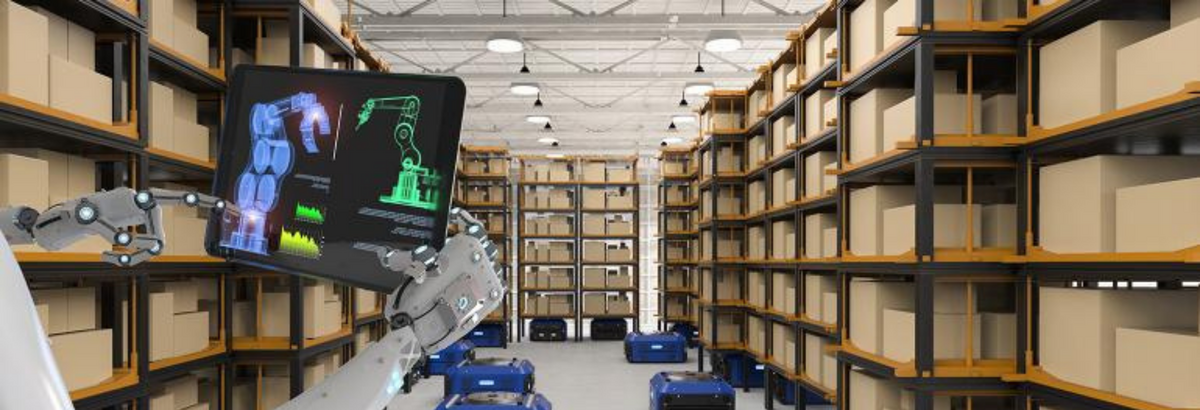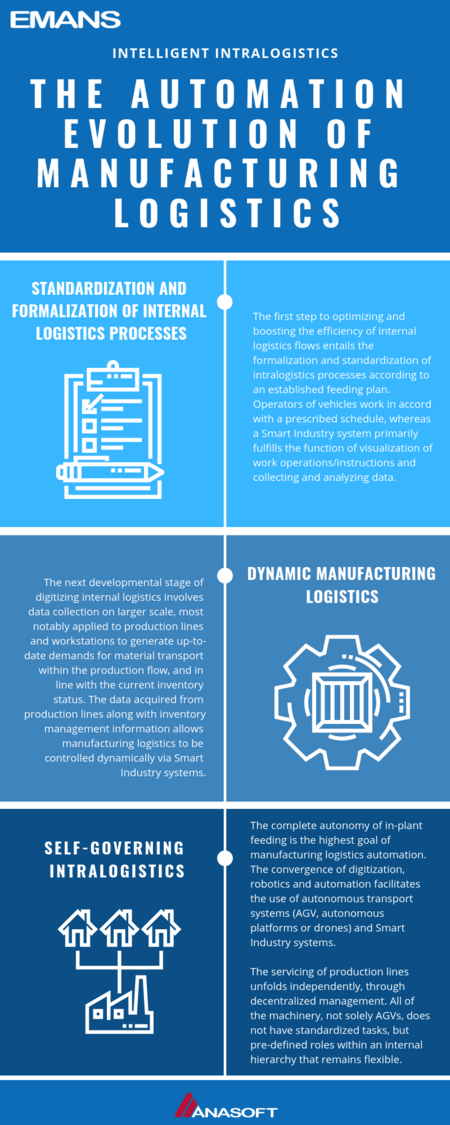3 Stages of In-Plant Logistics Automation | Intelligent Intralogistics
2019-02-22

Industry 4.0 technologies influence logistics in important ways. The digitization of the supply chain and automation of logistics processes – through technologies such as the industrial Internet of Things (IIoT), smart sensors, Big Data and artificial intelligence (AI), along with other new technologies – has paved the way to innovative, interconnected and smart logistics. Logistics 4.0 encapsulates also intralogistics and manufacturing logistics processes.
The efficiency of a company’s internal logistics determines overall delivery and handling performance. Digitization and the introduction of new and innovative technologies – such as gesture or voice control, augmented reality (AR), multi-agent systems and predictive analytics – plays an indispensable role in boosting and optimizing capabilities, lead times and overall performance. They also make processes more agile, rendering supply flow management faster and more cost-effective.
Owing to the modular nature and design of the new technology and Industry 4.0 solutions, the complete shift to digital doesn’t have to happen all at once. It can happen gradually, allowing companies and employees to progressively transition and adapt to the new technologies and learn how to use them effectively in their day-to-day operations.
Considering the modularity of intelligent logistics solutions and Smart Industry solutions (or Smart Logistics solutions), enterprises can customize and scale digitization and automation to address issues such as a lack of qualified labor or parts of the supply chain (such as bottlenecks) to improve performance. Modularity also enables enterprises to scale their digital transformation according to the company´s priorities, central strategy and expected challenges.
Whether it concerns inbound logistics, inventory or warehouse management or manufacturing logistics, a customized implementation and deployment enables the company to properly plan and execute its digital transformation strategy. Moreover, taking a gradual approach to logistics transformation allows the firm to consider crucial indicators and anticipated outcomes, such as improving the elasticity of processes to reduce reaction time for scheduled, unscheduled or emergency events in the material (supply) and manufacturing flux.
Intelligent Internal Logistics Management
Industry 4.0 brought a new impetus to the handling and flow of materials within an enterprise as new ways to manage intralogistics dynamically emerged. The Internet of Things (IoT), in combination with identification and tagging of items in a warehouse, allows the generation of logs and data analytics that support informed decisions regarding stocking and optimal control of inventory management.
The result is a leaner, more effective mechanism for warehouse operations; instead of a static management system, companies can use the dynamic and autonomous systems that Smart Industry solutions offer, along with autonomous algorithms to prioritize tasks in real time and govern processes. This enhances logistics agility in multiple ways.
The real-time resource survey and improved asset utilization enabled by Smart Industry solutions and new technologies reaches beyond inventory management when it comes to intralogistics processes. Manufacturing enterprises and factories often turn to digitization of internal logistics to autonomously coordinate and synchronize (schedule, control and monitor) material flow within manufacturing processes.
One common reason for optimizing internal logistics is delays in or insufficient servicing of production lines or other manufacturing equipment. Inefficient operation or inadequate utilization of vehicles on in-plant routes, or the desire to eliminate downtime, are other common reasons for optimization.
The 3 Stages of Intralogistics Automation
Enterprises have to evolve their established intralogistics processes to maintain their sustainability, while also reacting to the wider variability of manufactured products, optimized lead times and operating costs. They must also react quickly to external circumstances and market swings.
Moreover, as the amount of machinery, vehicles, equipment, personnel, inbound materials, semi-finished products and finished products within a factory or enterprise increases, intralogistics processes grow in complexity. Modern management systems (Smart Industry systems) are required to control and monitor them.
In enterprises, the digital transformation of intralogistics via Industry 4.0 technologies and principles unfolds in three stages:
1) Standardization and Formalization of Internal Logistics Processes
2) Dynamic Manufacturing Logistics
3) Self-Governing Intralogistics

Standardization and Formalization of Internal Logistics Processes
The first step to optimizing and boosting the efficiency of internal logistics flows entails the formalization and standardization of intralogistics processes according to an established feeding plan.
Operators of vehicles work in accord with a prescribed schedule, whereas a Smart Industry system primarily fulfills the function of visualization of work operations/instructions and collecting and analyzing data.
The visualization of work operations decreases the onboarding of new employees into the enterprise´s in-plant supply processes.
In such a case, a higher turnover does not necessarily produce a larger negative impact on the performance of the intralogistics processes, or their quality and speed. Automatic data collection can support evaluations of overall labor effectiveness, automatic inventory or labor write-offs.
Dynamic Manufacturing Logistics
The next developmental stage of digitizing internal logistics involves data collection on larger scale, most notably applied to production lines and workstations to generate up-to-date demands for material transport within the production flow, and in line with the current inventory status.
The data acquired from production lines along with inventory management information allows manufacturing logistics to be controlled dynamically via Smart Industry systems.
Smart Industry systems generate and assign tasks to logistics personnel based on real-time data analysis of feeding demands for production lines and manufacturing processes in the material flow.
Autonomous algorithms organize material transportation requests in regard to the current and projected extent of labor utilization and workload, thus eliminating idle time and non-productive tasks.
Subsequently, the system monitors the completion of assigned tasks and simultaneously directs fork-lift or tugger-trains operators to targeted production lines or workstations.
Meanwhile, logistics personnel have seamless access to precise, real-time information, so they can make timely and qualified decisions and react appropriately to emergency or unscheduled events.
In-plant feeding (manufacturing logistics) becomes sufficiently flexible, thanks to the optimization of all material flows by intelligent algorithms. Such Smart Industry solutions transforms traditional a Milk Run system into its dynamic and agile form – Milk Run 4.0.
An alternative solution is intralogistics automation, which deploys the automated guided vehicles (AGV) that service production lines and workstations on closed routes. A Smart Industry system coordinates AGV task fulfillment and autonomously synchronizes logistics and manufacturing processes based on real-time demands and circumstances.
Self-Governing Intralogistics – Autonomous Feeding
The complete autonomy of in-plant feeding is the highest goal of manufacturing logistics automation. The convergence of digitization, robotics and automation facilitates the use of autonomous transport systems (AGV, autonomous platforms or drones) and Smart Industry systems.
The fleet of AGVs and other transport equipment accomplishes tasks generated by the information system, and is controlled by artificial intelligence that uses predictive and prescriptive models derived from the results of analytics on big data sourced from logistics and manufacturing.
A Smart Industry system provides a distributed architecture, allowing for the mutual communication of manufacturing and transport machinery and reciprocal data exchange in real time (so-called machine-to-machine - M2M - communication).
In such a configured architecture, based on the principle of multi-agent systems, the engaged machinery and equipment, or rather their algorithms, decide for themselves how to behave according to the actual situation, demands and their own data sets.
The servicing of production lines unfolds independently, through decentralized management. All of the machinery, not solely AGVs, does not have standardized tasks, but pre-defined roles within an internal hierarchy that remains flexible.
Autonomous in-plant feeding belongs to the concept of the intelligent factory – the Smart Factory.
read more







